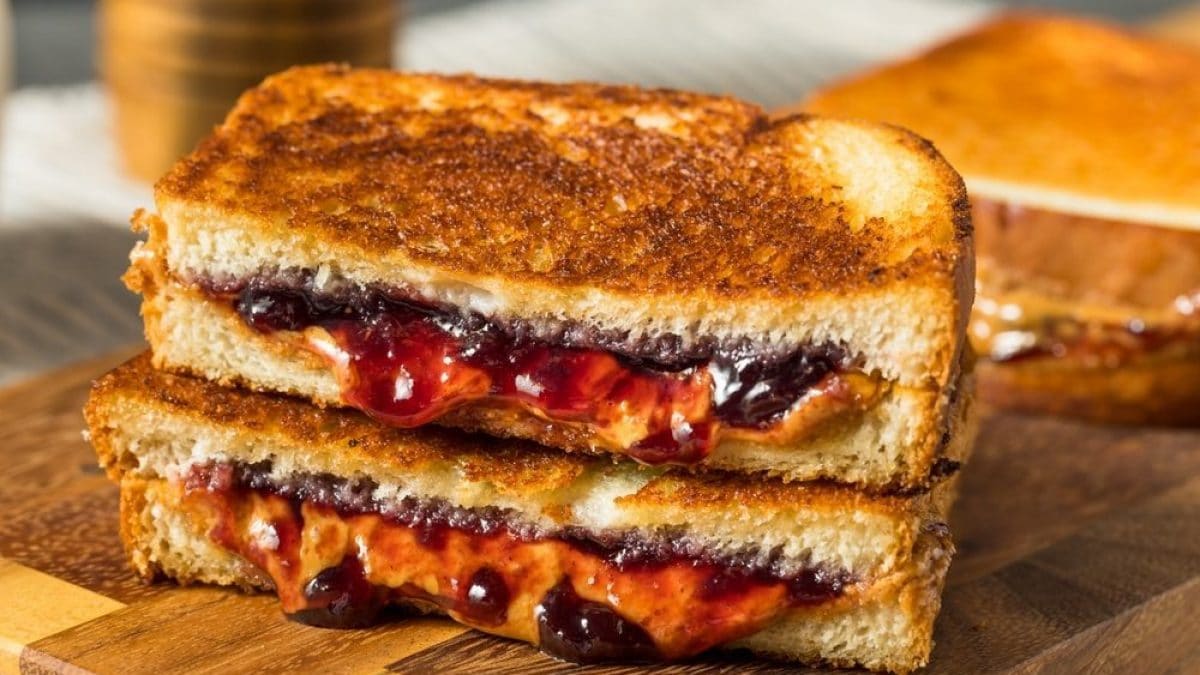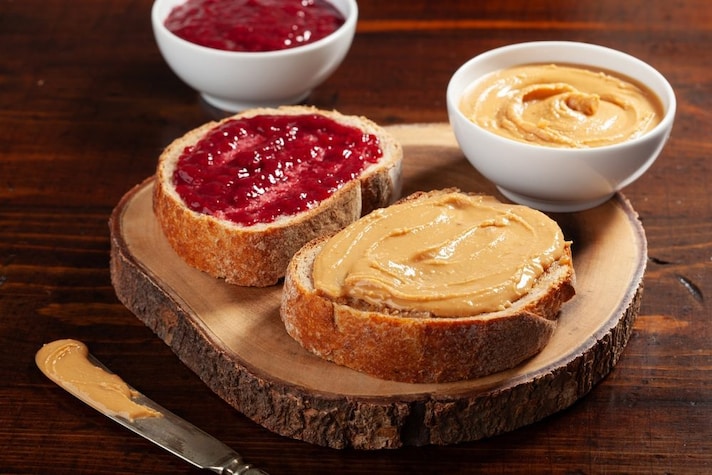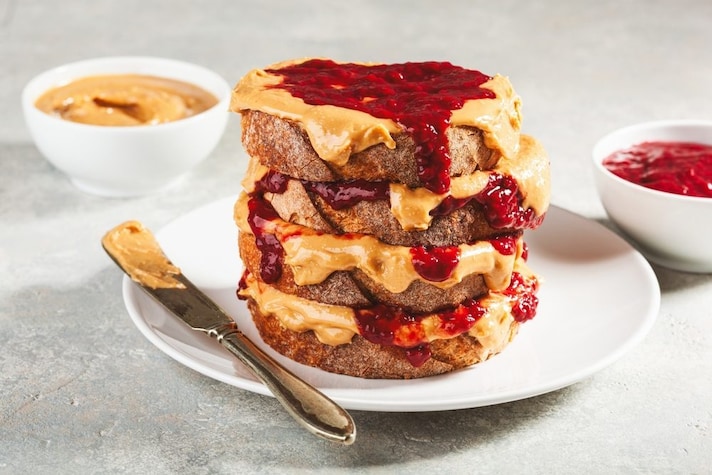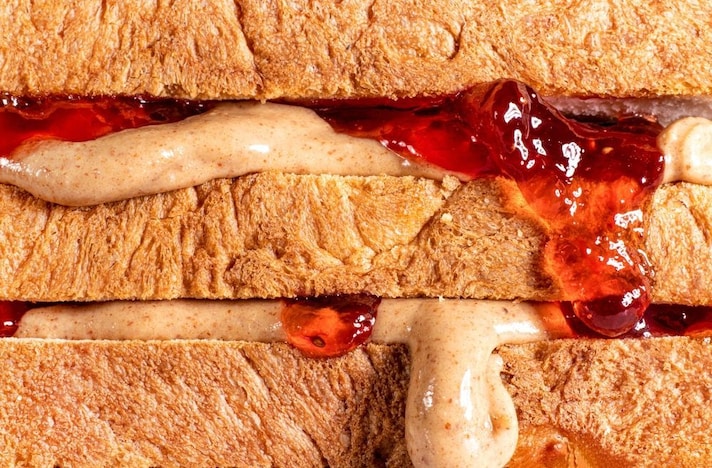
We have a specialty that could be considered the equivalent of European bread, butter and jam: enjoyed as a snack for generations and an integral part of the gastronomic (and cultural) heritage of the United States. We're talking about the peanut butter and jelly sandwich, also known as PB&J: simple to make and nutritious, much loved by children. Let's discover its history and how it became a true star of the stars and stripes.
What is a Peanut Butter and Jelly Sandwich and How Do You Make It?
A peanut butter and jam sandwich consists of two slices of bread, usually white and soft, filled with a layer of peanut butter and a layer of jelly or jam, terms often used interchangeably but which, in reality, refer to two different products. “Jelly” refers to a smooth gelatin, obtained by filtering fruit juice and cooking it with sugar and pectin until it reaches a firm, uniform consistency. “Jam,” on the other hand, is a preserve: it is made from the fruit pulp, can retain pieces inside, and has a soft texture. Both are perfect for spreading, used in PB&J depending on personal taste.
The preparation is very simple: spread peanut butter on one slice of bread (toasted or not), jam on the other, close the sandwich and, if you like, you can cut it diagonally or make a multi-layered version. The result is a winning combination: the creamy, savory texture of peanut butter and the sweet/tart flavor of jam, especially grape jelly (the original), strawberry jam, and raspberry jam.

A Story That Begins From Afar
We could say that the history of this sandwich is closely linked to its three ingredients: sliced bread, packaged jam, and peanut butter. Let's start with the latter, as it's considered an iconic food born in the USA. Peanuts, contrary to popular belief, are not a nut, but a legume (they belong to the Fabaceae family, like peas, chickpeas, and lentils) and were widely cultivated by the so-called pre-Columbian civilizations of the Incas and Aztecs. They were first exported to Europe by the conquistadors, then to Africa and back to North America on slave ships, increasingly becoming an important agricultural product.
Two names are linked to the birth and spread of peanut butter. The first is John Harvey Kellogg (yes, the one from Corn Flakes), who in 1895 patented a method for making peanut butter as a protein substitute for meat, aimed at the wealthier classes. The second is George Washington Carver, an African-American agronomist who promoted the cultivation of peanuts in place of cotton, which was threatened by a killer insect among Southern farmers. Much like Bubba, Forrest Gump's faithful friend, who was "obsessed" with shrimp and cooked them in a thousand different ways, Carver did the same, developing multiple ideas for using them in the kitchen, including making butter.

Around the same time, homemade jam had begun to be industrially packaged and marketed on a large scale. The peanut butter and jelly sandwich first appeared in 1901 in the Boston Cooking School Magazine, which offered mothers a recipe to try: "For variety, try one day making little rolls, or bread sticks, with three very thin layers of bread and two layers of filling, one of peanut paste, of your favorite brand, and the other of currant or crab apple jelly. The combination is delicious and, as far as I know, original," as reported by the website Epicurious.
The sandwich's popularity exploded when peanut butter became cheaper thanks to mass production, becoming a cheap, readily available, and protein-rich food, so much so that during World War II it was part of the rations of US soldiers along with grape jelly. And so we arrive at the years of the economic boom, when PB&J became the ideal snack for children, convenient, quick, and nutritious: even today, it remains a flavor linked to childhood, with a strong emotional and patriotic connotation.

Trivia: An Icon of Basketball, Cinema and TV Shows
As we've seen, the peanut butter and jelly sandwich isn't just a sandwich, but an American trademark that has also found its way into sports and entertainment, transcending national borders. For example, as La Repubblica reports, among NBA players it's called the "champions' sandwich": it all started with Kevin Garnett of the Boston Celtics who, legend has it, ate one with strawberry jam before a game, putting in an extraordinary performance. Biting into a PB&J before taking the court has thus become a gesture of good luck.
If we think about cinema, however, peanut butter remains the protagonist of one of the most memorable sequences in the cult film Meet Joe Black, in which Brad Pitt – who plays Death – goes to the kitchen of the large villa where he is staying and tastes it for the first time, wanting more, and walking around the house with a spoon in his mouth. As for the small screen, however, it is impossible not to mention Stranger Things, set in the 1980s: Joyce, the mother of one of the children played by Winona Ryder, prepares the sandwich for their snack. But it doesn't end there, because peanut butter appears in an emblematic scene that all fans of the series know well, with the character of Jim Hopper who, while imprisoned in Russia, accidentally finds a jar of it smuggled by the trafficker Yuri, known precisely as the Peanut Butter Smuggler, and tastes it by dipping his hand into the jar, immediately feeling at home.
;Resize,width=767;)